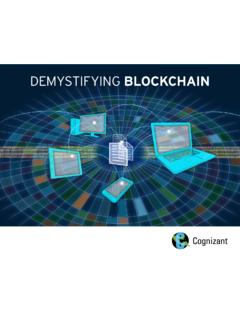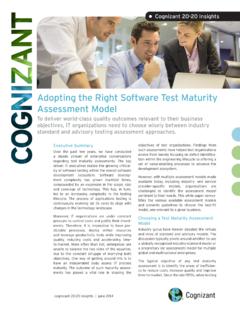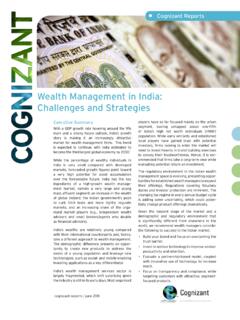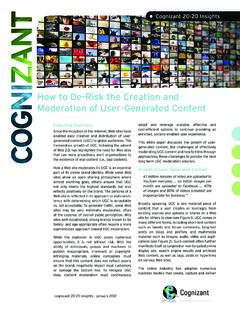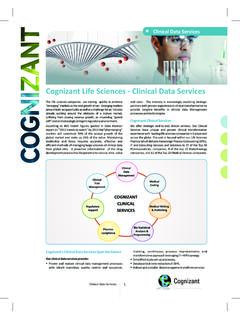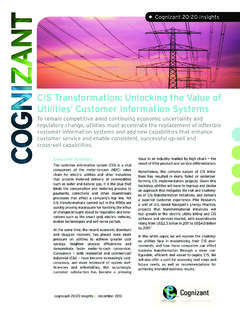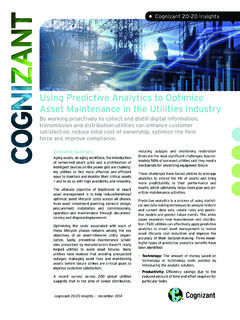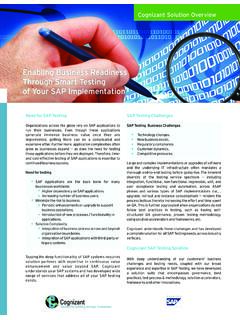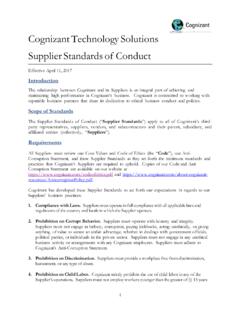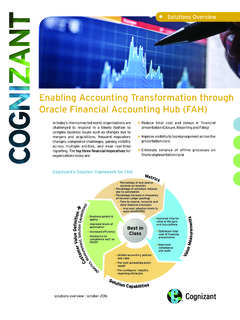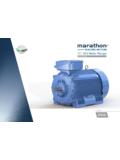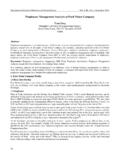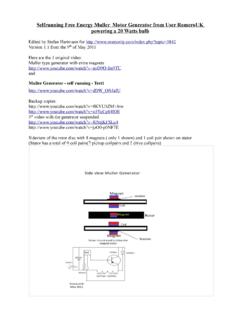Transcription of The Future of IT Infrastructure - Cognizant
1 IT that matters in the new machine age prioritizes cybersecurity, innovation, time-to-market and customer experience over cost-cutting, according to our latest study. Here s what the Future looks like for IT Infrastructure , as traditional businesses make the digital shift, including our HEROES framework to guide you along the way. By Manish BahlTHE Future OF IT INFRASTRUCTURE3 The Future of IT Infrastructure | Executive SummaryAs traditional businesses adapt to the realities of the new machine age breathless time to market, intelligently enhanced everything, meaningful and personalized experiences the implications for IT have been profound. It is no exaggeration to say that the core differentiator for a successful busi-ness today rests on the readiness of its IT Infrastructure and that an inflexible, sluggish, inefficient Infrastructure poses a bigger competitive threat than any ingenious start-up or disruptive market force.
2 While the legacy IT industry of servers, databases and cables is still important, it has essentially become a utility, taking a backseat to the need for an agile, flexible and quickly scalable technology foundation to drive business. Companies with legacy technology architectures, therefore, face a dilemma: striking a balance between the present and Future state of IT Infrastructure . To achieve this equilibrium, the first ballast to discard is IT s traditional obsession with cost-cutting. The simple fact is, a lower cost but completely irrelevant backbone will condemn you to lose in whatever market you operate in. To learn more about the Future needs of IT Infrastructure , Cognizant s Center for The Future of Work surveyed top IT executives at leading companies around the world, the majority of which have been in business for more than 15 years (see Appendix, page 24, for more details on the survey methodology).
3 Our objective was to gain insights into the changes leaders are making in their orga-nization s technology Infrastructure , as well as the shifting nature of IT work, operations, perfor-mance metrics and jobs to re-tool for the digital age. Based on our findings, we have developed a framework to help traditional businesses systematically move toward the new way of work for IT. The framework, dubbed HEROES, involves change in five areas: hybrid cloud architectures, edge computing, robotic process automation (RPA), obsoles-cence of old IT and enterprise security. Cutting across all five categories is the infusion of artificial intelligence (AI). Global business and technology decision makers can use our study findings, detailed in this report, as a practical guide to maximizing the strategic value of their IT investments.
4 This report is intended as a call to action that will enhance partnerships between IT and business to better manage the transformative impact of the new machine NEXT FIVE YEARS WILL DRIVE more CHANGE than THE PREVIOUS 50| The Future of IT Infrastructure4 The amount of change expected in the next few years is daunting, relentless and coming fast. Nearly 70% of the executives we surveyed agreed that their industry will change more in the next five years than it did in the previous 50. Little wonder, considering phenomena like the estimated three to five billion new consumers due to come online from developing economies, providing a mega-surge to the global economy;1 the number of IoT devices outnumbering the world s population by the end of 2017;2 and perhaps most important, the encroachment of AI into numerous entrenched societal challenges.
5 In fact, 68% of study respondents agreed that AI will have a transformational impact on their business by Future of IT Infrastructure | Respondents are already pushing ahead; we found that every business function, from sales and marketing, to finance, customer service and IT operations, is about to undergo a massive transfor-mation. Amid this widespread flux, business priorities will also shift between now and 2020 (see Figure 1, next page), according to our research: Cybersecurity will be key to building the brand. Companies that think cybersecurity is an IT problem or priority have already been hacked by the Future . By 2020, cybersecurity will top the list of business priorities, according to respondents. Online security threats are now a fact of life, moving organizations ability to mitigate risk from an inconvenient need to a necessary compet-itive advantage.
6 According to our study, companies endured an average of 40 security incidents in 2016 alone, costing each around $ million. Sixty-eight percent of respondents suffered loss of reputation and brand value as a result of a breach. Numerous additional incidents likely escaped the business s notice. Respondents see the situation worsening, with 60% saying there are more emerging threats than they can currently control, illustrating that the underlying IT Infrastructure is ill-equipped for the new machine age. Customer-facing technology will remain supreme. Although customer-facing technology transformation (websites, mobile apps, etc.) drops from first to third place between now and 2020 in our study, this priority is clearly here to stay. The winners in the digital economy will be those that own the customer relationship.
7 In fact, 68% of respondents named improving data management capabilities to enhance the customer experience as a top priority. AI will emerge as a key factor, with 66% of respondents citing the use of AI to better target customer offers. more than half of respondents (60%) plan to invest in chatbots to offer new customer interaction experiences and improve customer engagement. Innovation is no longer a luxury. Time-to-market of new products, services and experiences is a must in the digital economy. On average today, respondents said their company launched two or three new products or services annually, each taking seven to eight months to get to market. That is simply no longer fast enough. Almost half of survey respondents acknowledged that five years from now, those launch times will need to be cut in half. This will only happen if companies look outside their own four walls and join outside ecosystems, via platforms and partnerships.
8 Companies that exercise innovation for a purpose will succeed, as opposed to those building just another cool product or | The Future of IT Infrastructure6| The Future of IT Infrastructure6 Cost-cutting disappears as a top priority. Leading businesses are already using automation today to relentlessly cut costs, and many will have already reaped the cost benefits by 2020. The Future focus will be less about cost-cutting and more about investing in technologies and capa-bilities necessary for changing business requirements. For instance, Adidas Russia shifted its supply chain management focus from lowering costs to increasing sales. With better data insights, the company improved its delivery time to customers, which helped increase sales by up to 40%.3 From Business-Serving, to Business-Changing As business priorities quickly shift, so must the priorities and role of IT.
9 Over the next 24 to 36 months, we will see a new phase develop for IT organizations, in which they are measured on a very different set of metrics than ever before. The IT mandate will stretch beyond the familiar realm of satisfying customers and employees, collaborating with the business and reducing costs, to sealing the customer relationship, discovering new business value and enabling business agility and inno-vation while also ensuring security (see Figure 2, next page). In response, IT leaders are renewing their focus on the following areas: Strategically embedding themselves in the business to reclaim the mandate of preferred partner. Three-quarters of respondents are doing everything they can to break down remain-ing barriers between IT and their business peers. They are focused on spending more time with business leaders (76%), aligning their services portfolio with business functions (68%) and implanting IT staff in business units (56%) to encourage collaboration.
10 The encroachment of AI into many business functions will require increased business-IT collaboration, particularly as the goals for AI initiatives are to gain new and profitable insights into customers. Sixty-five percent Changing Times Spur Shift in Business PrioritiesWhich of the following will be your business priorities in the next 12 months? How will these change by 2020?50% 55% 56% 61% 67% Invest in cybersecurityto gain andkeep consumer trustCost reductionDevelop new digitalrevenue streamsEnter new marketsTransform customer-facingtechnology to improvecustomer acquisition/retentionNext 12 Months Top five categories 56% 60% 61% 63% 70% New strategic alliances or joint venturesAccelerate time to marketfor new product/service offeringsTransform customer-facingtechnologyto improvecustomer acquisition/retention Embrace platform thinking to encourage business innovationInvest in cybersecurityto gain and keepconsumer trust2020 Source: Cognizant Center for the Future of Work Base: 1,018 senior IT executives Figure 1of respondents are creating, planning or commissioning AI solutions with both IT and business involved.
